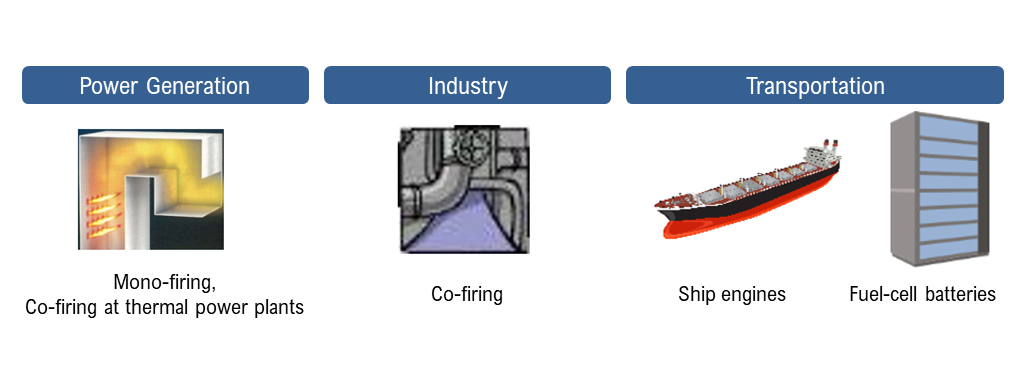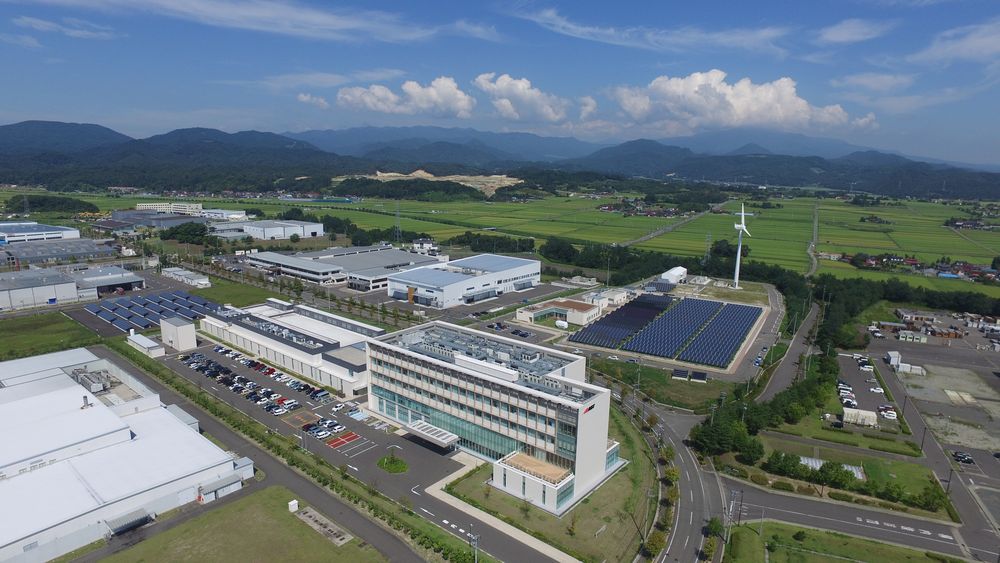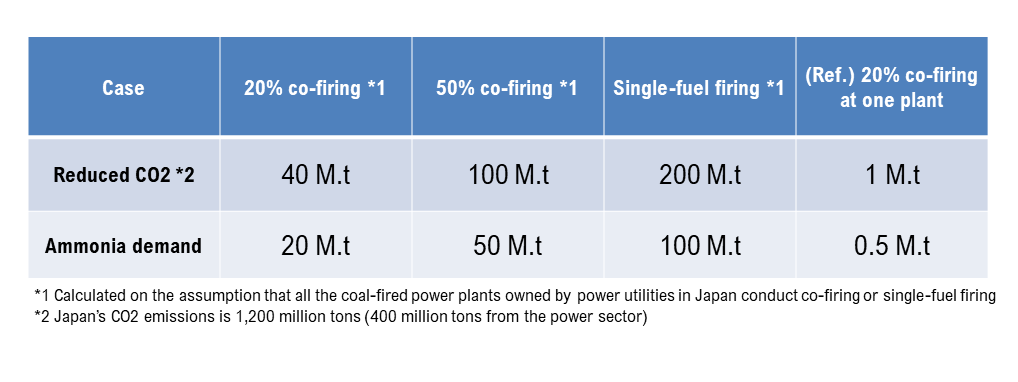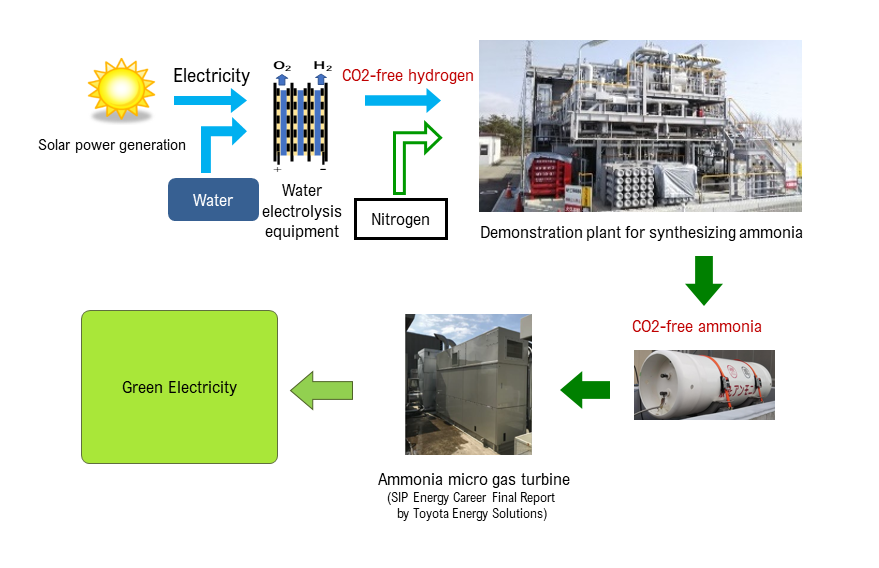Ammonia can be used as fuel!
Part 2: Carbon-free thermal power generation using ammonia
(in provisional translation)
(English ver.) 2023-10-20

Hekinan Thermal Power Station (Source: JERA website)
Besides the conventional use as a fertilizer, ammonia has great potential as a next-generation source of energy. Part 1 of this article outlined the basics of ammonia and its potential as a fuel. Part 2 focuses on the technologies for using ammonia as a fuel and efforts to overcome the challenge of delivering a stable supply of adequate quantities.
Large-scale demonstration of ammonia co-firing at a thermal power plant to reduce CO2
In recent years, fuel ammonia has been attracting attention as a next-generation source of energy because it emits no CO2 during combustion. Promising applications range from power generation and industrial use at factories to transportation.
Direct combustion of fuel ammonia

Technological development for co-firing of ammonia at coal-fired power stations is making progress at the fastest pace among other applications. CO2 emissions from thermal power generation account for around 40% of total CO2 emissions in Japan, against which countermeasures have to be implemented to achieve a low-carbonized society. One of those countermeasures is co-firing of ammonia, which is expected to develop into ammonia mono-firing sometime in the future.
Ammonia has been used globally with a wide range of applications, including fertilizer production, as explained in Part 1 of this article. Therefore, the existing infrastructure and technologies for production, transportation and storage could be utilized and expanded for increased use of ammonia. Safety measures and guidelines have also been well-developed. For instance, co-firing of ammonia at thermal power plants could be achieved by just changing burners without major modifications to other equipment. Therefore, utilizing ammonia as a fuel would require minimum infrastructure development with less upfront investment, offering a cost-effective way of reducing CO2 emissions.
Technological development for ammonia co-firing at thermal power plants was conducted from 2014 to 2018 under the Strategic Innovation Promotion Program (SIP) by the Cabinet Office, and certain results were achieved. Ammonia, which includes nitrogen as a chemical element, emits nitrogen oxide (NOx) during combustion. However, it has been proved that NOx emissions are controllable. Demonstration tests so far conducted indicate that NOx emissions from 20% ammonia co-firing can be controlled at similar levels to those of NOx emissions from 100% coal-fired operation.
However, those tests were conducted in small furnaces, and larger-scale demonstration tests are required for commercialization using an actual power plant. From FY2021, JERA, the largest thermal power company in Japan, will conduct a demonstration test of 20% co-firing at its Hekinan Thermal Power Station in Aichi Prefecture (1 million kW).
As explained in Part 1 of this article, if all the coal-fired power plants owned by the power utilities in Japan conducted 20% co-firing of fuel ammonia, it would reduce CO2 emissions by 40 million tons (1 million tons per plant). Moreover, if all those coal-fired power plants were converted to single-fuel firing ammonia plants, the reduction in CO2 emissions would amount to 200 million tons, which is half the amount of CO2 emissions from the power sector in Japan.
Gas-turbine power generation firing ammonia
In addition to co-firing at coal-fired power plants, various applications of fuel ammonia are under study. One of those applications is direct combustion of ammonia for gas-turbine power generation. Although there was a question about combustion efficiency in the past, technological development has been advancing in recent years with the involvement of organizations such as Tohoku University, the National Institute of Advanced Industrial Science and Technology (AIST), Toyota Energy Solutions, and IHI.
Gas-turbine power generation produces power with the turbine rotating by high-temperature, high-pressure gas that is generated by firing fuels such as natural gas (LNG). As in the case of coal-fired power generation, ammonia co-firing with natural gas is also being studied, with R&D conducted at small-to-medium sized gas turbines ranging from 50 to 2,000 kW. Furthermore, R&D for ammonia single-fuel firing has started.
With regard to larger gas turbines in the 100,000-kW class, R&D is also making progress. Liquid ammonia is separated into nitrogen and hydrogen by exhaust heat from the gas turbine, and then combusted in the gas turbine to produce power. If this develops successfully into larger gas turbines in the 550,000-kW class, a reduction in CO2 will amount to 1.1 million tons per one unit a year.
Although ammonia emits no CO2 during combustion, the process of producing hydrogen, a component of ammonia, from fossil fuels such as coal and natural gas, will emit CO2. Action is being taken with the aim of producing carbon-free fuel ammonia in real terms by using technologies such as Carbon dioxide Capture and Storage (CCS) and Carbon Recycling as well as using hydrogen produced from renewables. At Fukushima Renewable Energy Institute, AIST (FREA), demonstration research is underway to synthesize ammonia using hydrogen derived from renewables. It is planned to disseminate electricity generated by carbon-free fuel ammonia in the future.

(Source) The National Institute of Advanced Industrial Science and Technology (AIST)
Other applications include solid oxide fuel cells (SOFCs), which generate electricity from hydrogen. Kyoto University and IHI are advancing R&D for using fuel ammonia instead of hydrogen in SOFCs. Technological development and demonstration tests are being conducted, aiming at utilizing fuel ammonia in diesel engines for ships and industrial furnaces.
Efforts toward strengthening the supply chain
Efforts regarding fuel ammonia have just begun with great expectations from various quarters. As explained in Part 1 of this article, a private company has formulated a road map toward single-fuel firing of ammonia in the 2040s. For this purpose, the company plans to conduct various demonstration tests while building a robust supply chain for a stable supply of large quantities toward public implementation in the 2030s.
However, the utilization of fuel ammonia is facing the challenge of delivering a stable supply of adequate quantities. Around 80% of global production of ammonia is used to produce fertilizers, most of which are consumed within the producing countries. The increasing use of fuel ammonia will result in global supply shortages and price hikes. This situation may also have a great impact on the global fertilizer market.
To address these potential consequences, a Public-Private Council for the Introduction of Fuel Ammonia was inaugurated, aiming at building a stable supply chain of fuel ammonia. The council is comprised of private enterprises and public organizations. Private companies participating in the council include power companies using fuel ammonia, trading houses supplying ammonia, and equipment manufacturers possessing technical expertise. The council will discuss a pathway to the full-scale introduction of fuel ammonia while sharing the challenges toward building a supply chain.
- The Public-Private Council for the Introduction of Fuel Ammonia; Member organizations
- Private enterprises:
Mitsubishi Corporation, Marubeni Corporation, JERA, J-Power, JGC, IHI, Mitsubishi Heavy Industries, Nippon Yusen, The Institute of Energy Economics, Japan, the Clean Fuel Ammonia Association - Public organizations:
ANRE, JOGMEC, JBIC, NEXI
Before the inauguration of the Public-Private Council, a Clean Fuel Ammonia Association was established. The association is to study R&D and public implementation of fuel ammonia. Its members comprise 67 domestic companies, 14 foreign companies, universities, research institutes, and other industry-public-academia organizations (as of January 2021).
Experimental efforts have started for transporting fuel ammonia from Saudi Arabia. Furthermore, plans are being explored to produce it in foreign countries and areas such as the USA, Australia, and the Middle East for export to Japan. It is expected that Japan will lead the global market for fuel ammonia by building a stable supply chain quickly and disseminate technologies for combusting fuel ammonia, mainly in Asia.
Division in charge
About this article
Policy Planning Division, Natural Resources and Fuel Department, ANRE
About Special Contents
Research and Public Relations Office, Commissioner’s Secretariat, ANRE
![]() The original Japanese text of this article; Click here
The original Japanese text of this article; Click here

